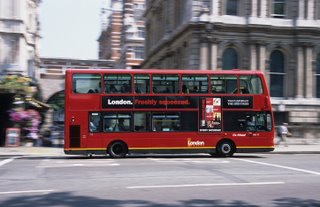 A modern double-decker bus cruises up Whitehall.
A modern double-decker bus cruises up Whitehall.Photo Credit: (c) Transport for London 2005
1. Take the Tube and Bus around London. The superb public transportation in London is a bargain, especially with an Off-Peak Day Travel card. It offers unlimited travel after 9:30AM for just £4.90 in central London. The Underground system (The Tube) is the quickest way around this often traffic choked city. Buses offer scenic travel. I particularly recommend two routes (Heritage route 9 and Heritage route 15) that operate in the heart of tourist London on historic double-decker buses. Transport for London
2. See London from the Thames on a hop-on hop-off cruise. Probably the cheapest way to see the river, this cruise stops at a number of convenient places between Westminster and St. Katharine’s Wharf. With the circular ticket priced at £7, you can get off and rejoin any boat later in the day. Crown River Cruises
3. Changing the Guard may be a tourist cliché, but it's truly is worth seeing, especially for the price (free). Get there early to get a good spot by the fence in front of Buckingham Palace. At 11:30AM Monday - Saturday from April until July and every other day except Sunday the rest of the year. May be cancelled due to rain. Buckingham Palace
4. A Church Service or Concert at Westminster Abbey or St. Paul’s Cathedral. Visiting London’s sacred spaces can be a bit expensive for the tourist. Most of them have daily worship which is, of course, free. See Westminster Abbey and St. Paul’s as they were intended – as places of worship. Most churches also offer concerts and recitals as well, the Church of St. Martin in the Fields in Trafalgar Square is a popular one.
2. See London from the Thames on a hop-on hop-off cruise. Probably the cheapest way to see the river, this cruise stops at a number of convenient places between Westminster and St. Katharine’s Wharf. With the circular ticket priced at £7, you can get off and rejoin any boat later in the day. Crown River Cruises
3. Changing the Guard may be a tourist cliché, but it's truly is worth seeing, especially for the price (free). Get there early to get a good spot by the fence in front of Buckingham Palace. At 11:30AM Monday - Saturday from April until July and every other day except Sunday the rest of the year. May be cancelled due to rain. Buckingham Palace
4. A Church Service or Concert at Westminster Abbey or St. Paul’s Cathedral. Visiting London’s sacred spaces can be a bit expensive for the tourist. Most of them have daily worship which is, of course, free. See Westminster Abbey and St. Paul’s as they were intended – as places of worship. Most churches also offer concerts and recitals as well, the Church of St. Martin in the Fields in Trafalgar Square is a popular one.
 The Lamb & Flag pub.
The Lamb & Flag pub.Photo Credit: Christopher Gould
5. Have a Pint of ale at a traditional pub. There are literally hundreds to choose from. I like ones in very old buildings with taps that require pumping to draw their precious liquid to your glass. One of my favorites is the Lamb & Flag near Covent Garden at 33 Rose Street. It’s one of the oldest in London, at the head of a crooked street.
6. See debate in Parliament. When Parliament is in session foreign visitors may not take the tour, but they can attend a session of either the House of Commons or House of Lords. Get in line at the St. Stephen’s entrance across from the rear of Westminster Abbey on St. Margaret’s Street. On busy days, the wait can be more than an hour. It is possible to arrange a Card of Introduction through the U.S. Embassy in London that will get you preferred entrance to the session, but they are extremely limited. Admission to the House of Lords is usually easier and their chamber is far more splendid than the Commons. If you appreciate history – remember that the Commons met in the chamber of the House of Lords for most of World War II because of bomb damage to their own chamber. UK Parliament
7. Eat Pie and Mash to experience London's traditional working-class food. There are pie shops all over, with some of the best in the East End. My favorite is Manze’s at 87 Tower Bridge Road. It dates from the reign of Victoria and it's not very different from the day it opened by the looks of it. This is as real as it gets -- traditional meat pie with mashed potatoes and parsley liquor. Expect to pay less than £5 for an entire meal. Truly London in a dish. Manze's
8. Go to the (Puppet) Theatre – An incredible jewel-like theater in tony Islington, The Little Angel Theatre, has presented puppets exclusively since 1961. While their normal ticket prices aren’t bad at all, usually about £9 for an adult, they offer a limited number of PWYC (pay what you can) performances where they request a minimum donation of £1 instead of a ticket. Their elaborate productions dazzle young and old alike.
9. Visit an art museum like The National Gallery in Trafalgar Square which houses treasures like Sunflowers by Van Gogh, Samson and Delilah by Peter Paul Rubens and works by Da Vinci, Vermeer and Michelangelo. The Tate Britain at Millbank on the Thames near Vauxhall Bridge showcases works of British artists, including the world’s largest collection of J.M.W. Turner. If your tastes are more contemporary, check out masterpieces by Picasso, Pollack, Monet, Matisse at The Tate Modern located in the former Bankside Power Station on the Thames opposite St. Paul’s. Admission to all three museums is free.
 The big guns outside the Imperial War Museum.
The big guns outside the Imperial War Museum.Photo Credit: Becky Gould
10. Relive the Blitz and D-Day at the Imperial War Museum. Perhaps the greatest military museum in the world has impressive collections focusing on the First and Second World Wars. The Blitz Experience is unique “a carefully researched reconstruction of an air raid shelter and a blitzed street in 1940. Appropriate sights, sounds and smells evoke for visitors a sensation of being caught in the bombing of London during the Second World War.” The Imperial War Museum is located on Lambeth Road in the landmark buildings that housed the Bethlem Royal (Mental) Hospital, better known as Bedlam in the Nineteenth Century.
Tweet



